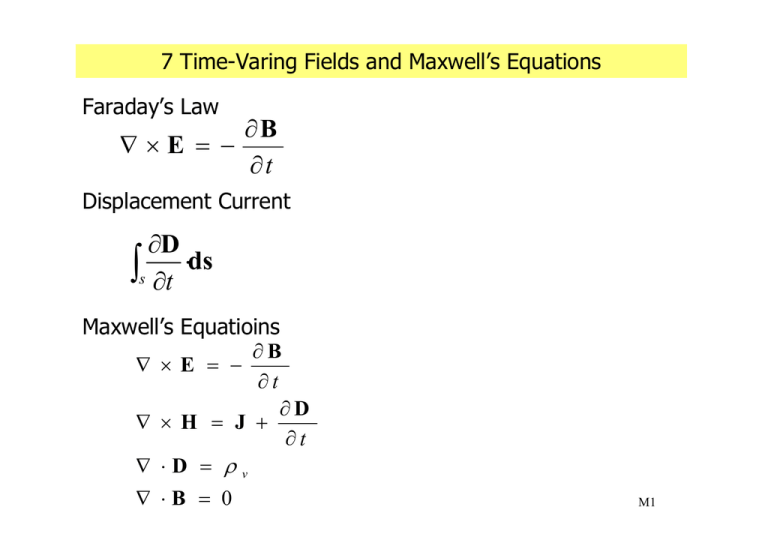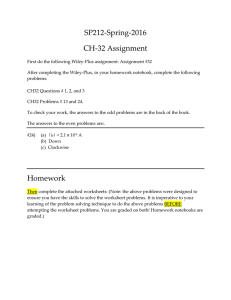Chapter 7 Time-Varying Fields and Maxwell`s Equations
advertisement

7 Time-Varing Fields and Maxwell’s Equations
Faraday’s Law
∂B
∇×E = −
∂t
Displacement Current
∂D
∫s ∂t ⋅ds
Maxwell’s Equatioins
∂B
∇ ×E = −
∂t
∂D
∇ × H = J +
∂t
∇ ⋅D = ρv
∇ ⋅B = 0
M1
M2
Revision: equations for static fields
Equations for static electric and magnetic fields
Differential form
∇×E = 0
∇ ⋅ D = ρv
∇×H = J
∇⋅B = 0
Integral form
∫ E ⋅ dl = 0
∫ D ⋅ dS = Q
∫ H ⋅ dl = I
∫ B ⋅ dS = 0
C
S
C
S
E:
D:
ρv:
H:
B:
J:
electric field intensity
electric flux density
volume charge density
Magnetic field intensity
Magnetic flux density
Electric current density
V/m
C/m
C/m3
A/m
T
A/m2
M3
Static Electric Fields
∇×E = 0
– energy used for moving an electric charge around a
closed loop is equal to zero
∇ ⋅ D = ρv
– the electric flux density emerging from a point equals to
the volume charge density
∇⋅B = 0
– Magnetic sources exists in pair (North and South pole)
∇×H = J
– magnetic field around a closed path equals to the
current inside
M4
Faraday’s Law
From Ampere’s Law, current can produce a magnetic field.
∫H
C
⋅ dl = I
From Faraday’s Law, magnetic fields can produce an
electric current in a loop, but only if the magnetic flux
linking the surface area of the loop change with time
B(t)
C
∂B
∫C E ⋅ dl = − ∫S ∂t ⋅ dS
where S is a surface bounded by
the closed line C.
∂B
In differential form, ∇ × E = −
∂t
M5
Fundamental postulate for time-varying EM fields
M6
Example: Stationary Loop in a Time-varying Magnetic Field
The induced emf is
Vemf
∂B
= −∫
⋅ dS
S ∂t
M7
Demonstration: D6.1 Circular Loop in Time-varying Magnetic Field
M8
Displacement Current
Consider a capacitor connected to a voltage source
Applying Ampere’s Law,
∫ H ⋅ dl = I enc
if
c1
is chosen, RHS is equal to Ic
if
c2
is chosen, RHS is equal to 0
C2
M9
Displacement Current
To resolve the conflict, Maxwell proposed the following
Ampere’s law in time-varying fields:
∫ H ⋅ dl = I
cond
= I cond
+ I Disp
∂D
+∫
⋅ds
s ∂t
I Disp : Displacement current
I cond : Conduction current
∂D
Point form : ∇ × H = J +
∂t
M10
Displacement current density
M11
Displacement current density
M12
Maxwell’s equations
• In summary, Maxwell’s equation for time-varying fields:
In differential form: ∇ × E = − ∂ B
∂t
∂D
∇ × H = J +
∂t
∇ ⋅D = ρv
∇ ⋅B = 0
In integral form:
∫
C
∫
C
∂B
E ⋅ dl = − ∫
⋅ dS
S ∂t
∂D
H ⋅ dl = I + ∫
⋅ dS
S ∂t
∫ D ⋅ dS = Q
∫ B ⋅ dS = 0
S
S
M13
Maxwell’s equations
M14
Example
Suppose the Electric field in a source free (i.e. ρv=0) region is given
by a wave travelling in the z-direction
E = E o sin( ω t − β z ) a x
Find the value of the magnetic field present. What must be the
value of β so that both fields satisfy Maxwell’s equations?
Solution: Substituting E into Faraday’s law,
∂B
= −∇ × E
∂t
∂
∂
∂
= − (a x
+ ay
+ a z ) × ( Eo sin(ω t − β z )a x )
∂x
∂y
∂z
∂
= − Eo sin(ω t − β z )a y = β E o cos( ω t − β z )a y
∂z
M15
Example
Integrating with time gives:
B=
∫βE
o
cos(ω t − β z ) a y dt
βE o
=
sin(ωt − βz )a y + Ca y
ω
In time-varying fields, we can ignore the DC term, so that
βEo
H=
=
sin( ω t − β z )a y
μ o ωμ o
B
This shows that an associated time-varying H-field must coexist.
M16
Example
To find the value of β, let’s substitute the above expression of H
into Ampere’s law:
⎞
∂ ⎛ βE o
∂E
= ∇ × H = − ⎜⎜
sin(ωt − βz ) ⎟⎟a x
εo
∂z ⎝ ωμ o
∂t
⎠
β 2 Eo
=
cos(ωt − βz )a x
ωμ o
Integrating with time, we find E to be
β 2 Eo
E= 2
sin(ωt − βz )a x
ω μ oε o
Comparing with the given expression of E
β = ω μo ε o ⇒ phase velocity u p = ω / β = 1 / μo ε o = 3 × 108 m / s
M17
Potential functions
M18
Potential functions
M19
Solution of Wave Equations for Potentials
M20
Solution of Wave Equations for Potentials
M21
Wave Equations of E & H in Source-Free Region
M22
Time Harmonic Electromagnetics
M23
Time Harmonic Electromagnetics
M24
Time-Harmonic Fields
In this chapter, both electric and magnetic fields are
expressed as functions of time and position.
– In real applications, time signals can be expressed as
sum of sinusoidal waveforms. So it is convenient to use
the phasor notation to express fields in the frequency
domain.
–
jωt
{
E( x, y, z, t ) ≡ Re E( x, y, z)e
}
j ωt
⎧
∂E( x, y, z , t )
∂E( x, y, z )e ⎫
≡ Re ⎨
⎬
∂t
∂t
⎩
⎭
= Re jωE( x, y, z )e jωt
{
}
M25
25
Time-Harmonic Fields
Therefore, the differential form of Maxwell’s equations
becomes the differential form time-harmonic Maxwell’s
equations
∂B
∇ ×E = −
⇒
∇ × E = − jω B
∂t
∂D
∇ × H = J +
⇒ ∇ × H = J + jω D
∂t
∇ ⋅D = ρv ⇒
∇ ⋅D = ρv
∇ ⋅B = 0 ⇒
∇ ⋅B = 0
D,E,B,H,J,ρv are functions of x,y,z
D,E,B,H,J,ρv are functions of x,y,z,t
A
:
n
o
i
t
n
e
t
At
o
t
lo
f
ua
q
e
M26
26
s
n
o
ti
Time-Harmonic Fields
Using the constitutive relations B = μ H and D = ε E
the equations becomes
∇ × E = − jω B
⇒ ∇ × E = − j ωμ H
∇ × H = J + jω D
∇ ⋅D = ρv
⇒ ∇ × H = J + j ωε E
⇒ ∇ ⋅E = ρv /ε
∇ ⋅B = 0
⇒ ∇ ⋅H = 0
,
M27
27
Wave equations in Source-Free Media
In a source-free media (i.e. charge density ρv=0),
Maxwell’s equations become:
∇ × E = − jωμ H
∵ J = σE
∇ × H = (σ + jωε ) E
∇ ⋅E = 0
∇ ⋅H = 0
The equation ∇ × H = (σ + jωε ) E
can be written as
∇ × H = jωε c E
where ε c ≡ ε '− jε ' ' ≡ ε − jσ / ω and it is called complex
permittivity.
M28
28
Wave equations in Source-Free Media
We will derive a differential equation involving E or H
alone. First take the curl of both sides of the 1st equation:
∇ × ∇ × E = − jωμ∇ × H
⇒ ∇ ⋅ E − ∇ 2 E = − jωμ ( jωε c )E
using the vector identity ∇ × ∇ × A ≡ ∇ ⋅ A − ∇ 2 A .
2
2
2
∂
∂
∂
∇2 ≡ 2 + 2 + 2
∂x
∂y
∂z
is an operator and called Laplacian
∇ × E = − jωμ H
∇ × H = jωε c E
∇ ⋅E = 0
29
∇ ⋅ H = 0M29
Wave equations in Source-Free Media
∇ ⋅ E − ∇ 2 E = − jωμ ( jωε c )E
⇒ ∇ 2 E + ω 2 με c E = 0
⇒ ∇ 2E − γ 2E = 0
2
2
γ
=
−
ω
με c and γ is called propagation constant
where
The equation is called the homogeneous wave equation for
E.
Similarly, we can obtain, (Try yourself)
∇2H − γ 2H = 0
∇ × E = − jωμ H
∇ × H = jωε c E
∇ ⋅E = 0
30
∇ ⋅ H = 0M30

